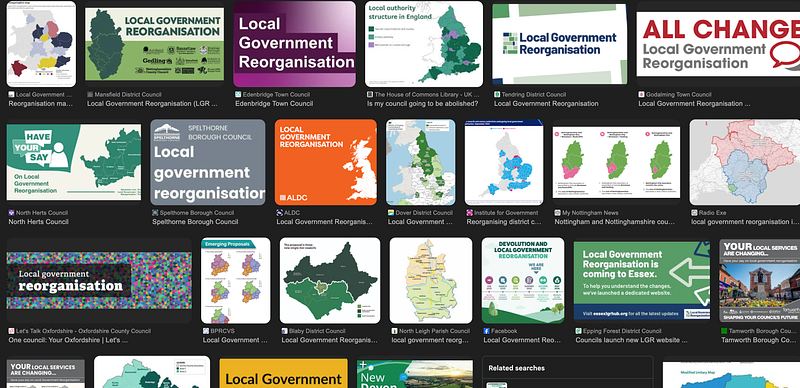The Business Case for Your Council’s Reorganisation is Probably Wrong. Here are Four Reasons Why.
Over the next few weeks, UK Citizens will (if they haven’t already) see a steady stream of updates from councils about Local Government…

Over the next few weeks, UK Citizens will (if they haven’t already) see a steady stream of updates from councils about Local Government Reorganisation (LGR). Most of it will sound confusing or irrelevant, and honestly, that’s not the fault of councils comms teams. Far from it, they’ve got an impossible job: explaining one of the biggest shake-ups in local services in a way that makes sense. The truth is, most people don’t really know (or need to know) how councils work, their administrative boundaries or how many councillors they have, they just want their bins collected, schools funded, and services to run smoothly.
But here’s the thing: Councils are also the grass roots of our democracy which is currently pretty fragile so this is also a chance to make local democracy easier to understand and more open, so people know how to get involved and influence the decisions that affect their lives and hopefully improve participation (and balance) bottom up.
However, I’m saving the democratic deep dive for another day but it’s worth mentioning it now as should be the foundational building block for our new reimagined councils and plays very much in to how we interpret all the information we are about to receive on the changes and plans for our own councils.
Introduction: More Than Just Lines on a Map
“Local Government Reorganisation” is a phrase that sounds so dry and bureaucratic it could put an insomniac to sleep. It conjures images of endless reports, committee meetings, and consultants shuffling spreadsheets. But these reorganisations are anything but abstract administrative exercises. They fundamentally reshape the public services we all rely on from the social care that protects vulnerable children and adults to the planning decisions that shape our communities and the public health strategies that keep us safe.
These are high-stakes, once-in-a-generation changes. Yet, what if the primary evidence used to justify them is based on a dangerously narrow view of success? What if the business cases driving these monumental decisions are focused on a single metric cost savings while ignoring the far more important factors that determine whether a council actually succeeds or fails? This article explores the critical factors and hidden risks that purely financial models for local government reform will often miss, and why they could be setting our communities up for failure.
The Plan Measures Cost, Not Value
The current approach to justifying reorganisation is almost exclusively focused on financial efficiency the simple idea of “doing the same for less money.” Business cases are built on the promise of economies of scale and savings from reducing duplicated leadership and back-office roles. While these are valid considerations, they represent only a tiny fraction of a council’s true purpose and impact.
By viewing local government through such a narrow financial lens, these plans fail to measure the broader forms of value that councils are created to deliver. These include:
- Social Outcomes: The real-world impact on citizen well-being, the strength of community cohesion, and the pursuit of equity for all residents.
- Economic Development: A council’s vital role in creating the conditions for local growth, attracting investment, and fostering a prosperous economy.
- Service Quality: Whether services are not just cheaper, but actually better, more effective, and more accessible to the people who need them.
- Democratic Health: The impact of reorganisation on local identity, citizen engagement, and the fundamental accountability of elected members to their communities.
By focusing only on cost-cutting, we risk creating councils that are “efficient” on paper but utterly ineffective at their core mission: shaping a thriving local economy and a resilient, healthy community. This contrasts sharply with fragmented models, which often hide the immense and recurring transaction costs of forcing multiple new councils to constantly negotiate collaboration on everything from transport to health.
It Ignores the Real Financial Ticking Time Bomb: Demand
The most significant flaw in a purely financial model is that it completely ignores a council’s ability to reduce demand for its most expensive services. The models calculate the cost of managing current demand under different structures, but fail to account for the single most important factor in long-term financial sustainability: prevention.
The largest and most volatile costs for any council are in its demand-led services, such as adult social care, children’s services, and support for the homeless. The key to controlling these budgets is not back-office efficiency, but strategic investment in services that stop problems from escalating in the first place. A holistic plan recognises the power of prevention:
- Early Childhood Intervention: Investing in programs that support vulnerable families is far cheaper and more effective than dealing with the immense human and financial cost of family breakdown later on.
- Healthy Aging Programs: Supporting community-based services that keep older people active, independent, and connected at home directly reduces the future demand for expensive residential care.
- Public Health Initiatives: A strong, unified public health function can effectively tackle the root causes of poor health that drive demand across the entire system.
- Place Based Approaches: Long term strategic planning and spatially nuanced planning for homes, infrastructure, and investment is just as critical. When and where councils plan for housing, transport, health, and economic development creates the conditions that reduce demand on crisis services in the first place.
A business case that ignores this dynamic is dangerously incomplete. As the evidence shows, the true measure of a council’s long-term health is its ability to manage future need.
The financial sustainability of any new council depends more on its ability to control these costs than on back-office efficiencies.
It Discounts the Immense Human Risk of Change
Financial models can calculate the cost of splitting services for example, the salary of “duplicated directors.” What they completely miss is the massive human and operational risk involved in breaking up complex, sensitive services, especially in areas like social care.
Splitting established teams responsible for vulnerable people should be handled with kid gloves and understood as a vast and interconnected system. Done badly, tt can shatter institutional memory built over years, fracture vital practitioner networks, and destabilise leadership at the most critical time. The models see a line on a spreadsheet, but the reality is a high-stakes operation where mistakes have profound human consequences.
The true cost of getting this wrong is not financial, but human. The focus should be on “the value of a safeguarding failure avoided.” A single catastrophic service failure, such as a failed Ofsted or CQC inspection, can cause immense human tragedy. The resulting financial costs of intervention and recovery will invariably wipe out any projected savings from the reorganisation, exposing the folly of a cost-first approach.
The Myth of Easy Technology Savings
Of all the promises made in reorganisation business cases, none is more seductive or more misleading than the idea of easy technology savings. The vision of merging multiple IT systems into a single, efficient platform is presented as a straightforward benefit of scale. The reality is a strategic minefield of spiralling costs, operational paralysis, and long-term financial traps that are almost never accounted for in the initial projections.
The Timeline Misalignment and the Myth of Immediate Savings System rationalisation takes years, not months. The initial business case promises savings, but the reality is that IT costs increase significantly in the short-to-medium term. During the multi-year transition, the new authority must pay to support all the old legacy systems simultaneously, even while it spends millions on the new one. The savings, if they ever materialize, are a decade away; the costs are massive and immediate.
The Customization vs. Standardization Paradox Leaders face an impossible choice. They can heavily customize the new, single system to replicate all the different processes from the old councils. This avoids immediate disruption but defeats the entire purpose of standardization, inflating costs and complexity. The alternative is to force a standardized “one-size-fits-all” process on thousands of employees, causing massive operational disruption, a crash in productivity, and widespread staff resistance.
Data Migration Hell is Real The idea of a simple “lift and shift” of data is a fantasy. The reality is a monumental technical challenge:
- Incompatible Systems: Each district’s core systems have been heavily customized over decades to fit specific local processes, bylaws, and data structures. Mapping these deeply entrenched, incompatible models into a single structure is profoundly complex.
- Data Cleansing: Combining decades of data from multiple systems — each with different formats, quality levels, and errors — is an expensive and painstaking task.
- Rebuilding Interfaces: Critical systems are connected to a web of other platforms for payments, mapping (GIS), and document management. This entire ecosystem of integrations must be rebuilt from scratch, at great expense.
The Long-Term Financial Trap Even if a council navigates this minefield, it walks directly into another trap. By consolidating onto a single vendor’s platform, the new unitary authority becomes a “captive client.” The cost and disruption of switching systems again in the future is so prohibitively high that the council loses its negotiating power, leaving it vulnerable to poor service and inflated fees for years to come.
Conclusion: Penny-Wise and Pound-Foolish
A business case for local government reorganisation that rests solely on narrow financial efficiency is not fit for purpose. It mistakes a single, simple input for the complete, complex answer. It is a plan that is penny-wise but pound-foolish, saving money in the back office while risking a fortune in increased service demand, missed economic opportunities, and catastrophic service failure.
A robust plan must be holistic. It must weigh financial modelling alongside a rigorous assessment of People, Strategic Economic Value, Demand Management, Service Quality & Risk, Resilience, and Community & Place.
Ultimately, any community facing this level of change must ask a fundamental question. The goal of reorganisation shouldn’t be to create councils that are just better at cutting costs, but to create councils that are better at improving lives. Is the plan on the table designed to achieve that?
